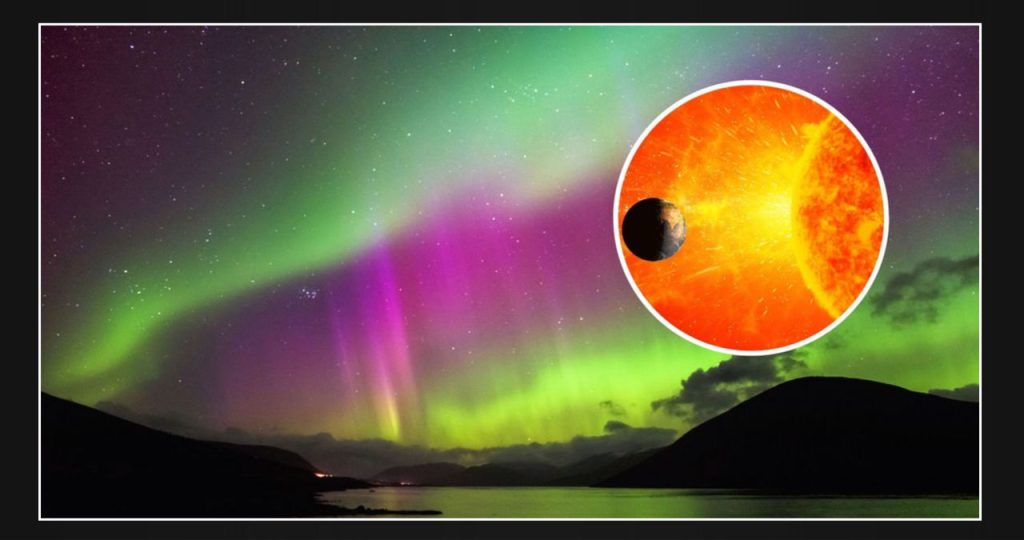Tonight, as our planet is hit by solar storms, individuals residing in the northern regions of the United States may have the opportunity to witness the mesmerizing spectacle of the northern lights.
Our magnetic field is about to experience a collision with a train of coronal mass ejections (CMEs) from the sun. As a result, G2-class geomagnetic storms are expected to occur in our atmosphere. This may lead to the fascinating phenomenon of auroras being visible in areas as far south as New York and Idaho.
According to a forecast by NOAA’s Space Weather Prediction Center on Monday, increased activity has been linked to a number of CMEs, with at least four of them having components that are expected to be directed towards Earth. These components could potentially arrive starting from Tuesday and lasting until Thursday. In response, geomagnetic storm watches have been issued, with a G3 watch for July 30 and G2 watches for July 31 and August 1.
Although a “cannibal” coronal mass ejection (CME) hit us yesterday, the anticipated G3-class storms did not materialize. Instead, only G1-class storms were observed.
Gigantic clouds of solar plasma are known as CMEs, which are ejected from active regions on the surface of the sun. The realignment of magnetic fields usually triggers these CMEs, and they contain fragments of the sun’s magnetic fields along with charged particles. When these CMEs are directed toward the Earth, they cause powerful geomagnetic storms as they interact with our planet’s magnetic field.
Geomagnetic storms funnel charged particles from CMEs towards the atmosphere near the poles, where they react with oxygen and nitrogen to form the breathtaking auroras. When the storms are stronger, the auroras can be seen further towards the equator.
Geomagnetic storms are rated using the G-scale, ranging from G1 to G5. G1 storms may cause minor fluctuations in the power grid, minor interference with satellite operations, and possible minor auroras at high latitudes. On the other hand, G5 storms can lead to widespread power system issues, potential damage to transformers, satellite navigation degradation, and auroras visible in Florida and Texas.
The most recent G5 storm happened on May 10th of this year, causing the northern lights to be visible across all 50 states in the U.S. It’s worth noting that the last time we had a G5 storm was back in 2003.
Over the weekend, scientists witnessed the formation of Cannibal CMEs, which takes place when multiple CMEs are discharged from the sun in a sequence, and one overtakes the other, resulting in a bigger and more forceful CME. As a result of this phenomenon, researchers anticipated G3 storms to happen on July 30, but to their surprise, only G1 storms were observed.
It’s possible that the reason for the lack of major disruptions during the CME event was due to the orientation of the magnetic fields. They may not have aligned properly with the Earth’s magnetic field, resulting in a lack of significant impact.
Predicting the strength of a geomagnetic storm can be a challenging task as it is difficult to measure the magnetic field of a CME before it approaches us.
Martin Connors, a professor of space science and physics at Athabasca University in Canada, explains that predicting the future is a difficult task, as Mark Twain once said. According to him, determining the magnetic field is a challenging task, and it remains a wildcard until it is directly measured, which takes less than an hour of travel time upstream.
Aurora low on the northern horizon – as captured from NWS Goodland during the late evening on Monday July 29 and very early morning on Tuesday July 30, 2024. Note: this video is a series of 30s exposures at ISO 800 (i.e. wasn’t visible to the naked eye). #kswx #cowx #newx pic.twitter.com/vmjby3YE96— NWS Goodland (@NWSGoodland) July 30, 2024
Although the G1 geomagnetic storms last night were not very impressive, there were still some faint auroras that were observed and photographed in Kansas. However, in Arizona, these auroras were not visible to the naked eye. With multiple CMEs expected to hit the planet today, there is a possibility of G2 storms that could result in even more breathtaking northern lights.
